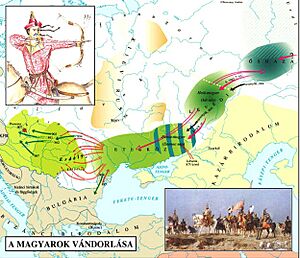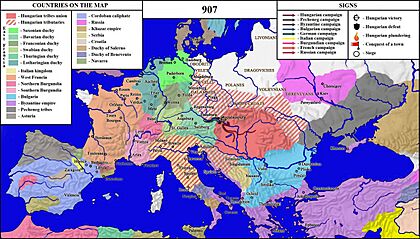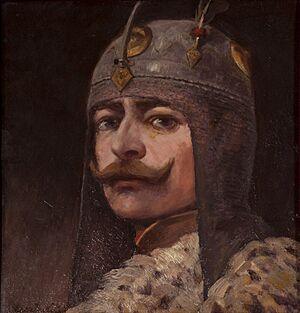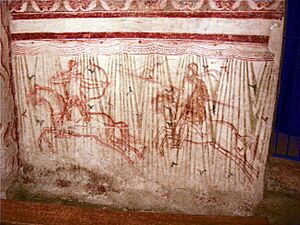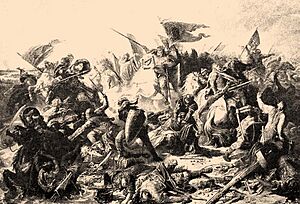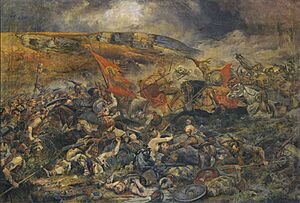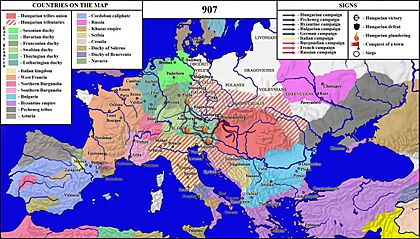Battle of Pressburg facts for kids
Quick facts for kids Battle of Pressburg |
|||||||
|---|---|---|---|---|---|---|---|
| Part of Hungarian Conquest | |||||||
 Peter Johann Nepomuk Geiger: Schlacht bei Pressburg (1850) |
|||||||
|
|||||||
| Belligerents | |||||||
| East Francia | Principality of Hungary | ||||||
| Commanders and leaders | |||||||
| Louis the Child Luitpold, Margrave of Bavaria † Dietmar I, Archbishop of Salzburg † Prince Sieghard † |
Grand Prince Árpád (?) Unknown Hungarian commander |
||||||
| Casualties and losses | |||||||
| Heavy, among other losses: Prince Luitpold, Margrave of Bavaria, Prince Sieghard, Archbishop Theotmar of Salzburg, 2 bishops, 3 abbots and 19 counts | Not significant | ||||||
The Battle of Pressburg (also known as the Battle of Pozsony or Battle of Bratislava) was a major three-day battle fought from July 4 to 6, 907. During this battle, the army of East Francia (an early German kingdom), made up mostly of soldiers from Bavaria, was completely defeated by Hungarian forces. The Bavarian troops were led by a military leader named Margrave Luitpold.
The exact place where the battle happened is not fully known. Old records mention a place called "Brezalauspurc." Some historians think it was near Zalavár in Hungary, while others believe it was close to modern-day Bratislava, which is the more common idea.
This battle was very important because it meant that the Kingdom of East Francia could not get back control of lands they had lost to the Hungarians, like the area that later became Austria. Most importantly, the Battle of Pressburg helped the Hungarians secure the lands they had recently taken over in the Hungarian conquest of the Carpathian Basin. It stopped a German invasion that could have threatened their future and helped establish the Kingdom of Hungary. Many see this battle as one of the most important in Hungarian history, marking the end of their conquest of the Carpathian Basin.
Contents
Why the Battle Happened
In the year 900, the advisors to the new young king of East Francia, Louis the Child, decided not to continue their alliance with the Hungarians. This alliance had ended when the previous king, Arnulf of Carinthia, died. Because of this, the Hungarians took control of a region called Pannonia (modern-day Transdanubia) from the Duchy of Bavaria, which was part of East Francia. This event started a war between the Hungarians and the Germans that lasted until 910. Before the Battle of Pressburg, most of the fighting was between the Hungarians and the Bavarians.
After losing Pannonia, Luitpold, the Margrave (a type of military governor) of Bavaria, joined forces with Bavaria's old enemy, Mojmir II of Moravia. By 902, Hungarian armies had defeated Great Moravia and taken over its eastern parts. This meant the Hungarians now controlled or influenced much of Moravia, which cut off Bavaria's trade routes to northern and eastern Europe. This was a big economic problem for Bavaria. Luitpold also wanted to get back the lands Bavaria had lost, like Pannonia, Moravia, and Bohemia.
Luitpold felt more determined to fight the Hungarians after some smaller victories. His forces had defeated some Hungarian units in minor battles in 901 and 903. In 904, the Bavarians tricked a Hungarian leader named Kurszán into peace talks and then killed him. After these events, the Hungarians did not attack Bavaria for a while. Luitpold believed the Hungarians were afraid of his army, and he thought it was the right time to drive them out of the lands that used to belong to Bavaria.
Army Leaders
The official leader of the Bavarian army was Louis the Child, the King of East Francia. However, since he was too young to rule, the real commander was Margrave Luitpold. Luitpold was an experienced military leader who had fought the Moravians successfully. He had also won some smaller battles against Hungarian raiding parties, but he had lost the important region of Pannonia to them.
Many historians think that Árpád, the Grand Prince of the Hungarians, led the Hungarian forces. However, there is no clear evidence for this. It is more likely that an unknown but very skilled commander led them. This commander probably also led the Hungarians to victory in other major battles of that time, like those at Brenta, Eisenach, Rednitz, and Augsburg. These battles were big wins for the Hungarians, causing huge losses for their enemies, often including the enemy commander.
This unknown Hungarian commander used very effective tactics:
- Psychological warfare: They would scare and confuse the enemy with constant attacks. They might also pretend to be weak or offer fake peace talks to make the enemy overconfident, then attack by surprise.
- Feigned retreat: They would pretend to run away to trick the enemy into chasing them, then suddenly turn around and attack.
- Good intelligence: They gathered information about the enemy, which helped them avoid surprises and attack before German armies could join forces.
- Fast movement: Their quick movements and deployment of units often surprised enemy troops.
- Crossing obstacles: They could secretly cross rivers or even seas that the enemy thought were impossible to cross, then attack unexpectedly.
- Nomadic tactics: They used tactics like swarming, hiding troops, and ambushes. They focused on surprise, quickly moving their cavalry and skilled horse archers.
- Patience: They would sometimes wait for days or weeks for the perfect moment to attack and win the battle.
- Discipline: Their soldiers were very disciplined and followed orders perfectly.
- Targeting commanders: They often tried to kill the enemy's leader. This weakened the enemy and scared other leaders.
After 910, the Hungarians continued to win many battles across Europe. However, they rarely killed the enemy commander after this period. Some historians believe that after 933, the Hungarians no longer had this great, unnamed commander. They started making mistakes, which led to defeats. For example, in the Battle of Riade, they didn't know about the German king Henry the Fowler's new military plans until it was too late. Another example is the Battle of Lechfeld (955), where Hungarian commanders Bulcsú and Lél lost control of their troops. Soldiers started looting, thinking they had won, and were then surprised by a German counter-attack. This led to a major defeat, and the captured Hungarian leaders were executed.
Getting Ready for Battle
In 907, Luitpold called for a large Bavarian-German army to gather near a place called Ennsburg. He hoped to win a decisive victory against the Hungarians, who had formed a strong new state in the Pannonian Basin. Bavarian leaders, including military and church officials, met on June 15, 907, to plan the attack. They decided that "the Hungarians must be removed from Bavaria." At that time, Bavaria claimed lands that included Pannonia and other areas that the Hungarians had taken. This shows how important this campaign was for both sides.
King Louis the Child and his advisors hoped this campaign would be as successful as Charlemagne's victory against the Avars in 803. Margrave Luitpold, the real commander, let the young king accompany them as far as the St. Florian Monastery. The king stayed there, showing how confident they were of a victory.
German records from that time say that the Bavarian leaders were very proud and overconfident. This was probably because they had killed Kurszán in 904 and won some smaller battles. The Hungarians likely used this overconfidence to their advantage. They might have tricked the Bavarians into thinking they were in a weak position, making the Germans believe it was the perfect time to attack. The German army even brought many important church leaders with them, showing they expected a complete victory and planned to quickly restore Christianity in the conquered lands.
Some historians suggest the Bavarian attack was caused by a false rumor that Árpád, the Grand Prince of the Hungarians, had died. They might have thought his death would weaken the Hungarians. However, there is no strong proof that Árpád died in 907, and many historians believe the dates given by some old Hungarian chronicles are incorrect.
On June 17, 907, the German army crossed the Hungarian border. They split into three groups and moved east along the Danube River. Luitpold led the main force on the northern bank. Archbishop Dietmar led forces on the southern bank, along with two bishops. A fleet of ships, led by Prince Sieghard, sailed on the Danube. This fleet was meant to keep the land groups in touch and carry supplies and heavy soldiers. Luitpold might have copied Charlemagne's successful strategy against the Avars. However, he didn't realize that the Hungarians would fight differently. Dividing the army into three groups turned out to be a big mistake. It allowed the Hungarians to attack and defeat each smaller group separately.
The Hungarians knew about the Bavarian attack long before it happened. They had gathered good information, which allowed them to prepare for a long time. This use of military intelligence was a key reason for their success in the early 10th century.
We don't know the exact size of the armies. However, the Bavarians were so confident in their numbers that they split their army, thinking each part was larger than the entire Hungarian force. Some sources suggest the Hungarian ruler had about 20,000 soldiers. It's likely that most Hungarian warriors from all their tribes gathered to fight the Bavarians, making their army around 20,000 strong.
The Battle
Old European records don't give many details about the battle itself, only that the Bavarian army was destroyed. However, a historian named Johannes Aventinus, writing 600 years later, provided a more detailed description based on older documents that no longer exist.
Since the Hungarians knew about the attack, they likely moved all people and livestock from the border areas (called gyepű) between the Enns and Pressburg rivers to the east. They also destroyed any food they couldn't take, using a "scorched earth" tactic. This meant the enemy would find nothing useful. Nomadic groups often used this tactic to weaken invading armies by causing famine.
Aventinus wrote that after the German army crossed the border, Hungarian commanders sent small groups of fast, lightly armored horse archers. These archers would attack the German communication lines, kill messengers, and constantly bother the army groups. This kept the Germans tired and on edge. When the Hungarian archers attacked, the Bavarians would chase them, but the Hungarians, with their lighter armor and faster horses, would easily ride away. The heavily armored Bavarian cavalry was much slower. This constant harassment slowed the German army's movement. It took them 18 days to travel 246 km, averaging only 14 km per day. This delaying tactic allowed the Hungarians to choose where and when the main battle would happen. They chose the area near Pressburg because it was good for a nomadic army.
The Hungarians continued to harass the Germans as they moved east, distracting them from the main attack. The main attack began on July 4, focusing on the southern bank of the Danube, against the army group led by Archbishop Dietmar.
The attack started with Hungarian archers riding towards Dietmar's troops, shooting a "shower of arrows" from their powerful composite bows. The Germans were completely surprised and retreated. Even when they managed to get into battle formation, the Hungarians kept attacking. They would appear from hidden spots like woods or riverbeds, shoot arrows from a distance, and then disappear. They would attack again, retreat while shooting arrows at their pursuers, then suddenly turn and attack again, surprising the Germans and causing many losses.
This was the famous nomadic tactic of the feigned retreat. The Hungarians used many tricks, fast movements, and sudden appearances and disappearances. This confused the German commanders, who didn't know which attacks were serious and which were bluffs. As a result, the Germans became tired, demoralized, and their battle order broke down. Finally, when the Germans were completely confused and losing hope, the Hungarians suddenly attacked them from all sides, surrounding and destroying Dietmar's southern army. It seems Luitpold, whose army was on the northern bank, couldn't help Dietmar's forces because he couldn't cross the river. The first day of the battle ended with the slaughter of the southern army, including Archbishop Dietmar and several other important church leaders.
That night, the Hungarian army secretly crossed the Danube and attacked Luitpold's forces in their camp while they were sleeping. This was similar to the Battle of Brenta in 899, where the enemy thought a river would protect them, but the Hungarians crossed it and attacked by surprise. The Hungarians used inflated animal skins to help themselves and their horses float across rivers. The attack caught the Germans completely off guard. Many were killed by arrows, some likely in their sleep. The Hungarians probably surrounded the camp, trapping the Germans and preventing them from escaping or forming battle lines. They shot arrows relentlessly until almost everyone was killed. Luitpold and 15 other commanders were massacred. It seems Luitpold didn't even know about Dietmar's defeat, which suggests his army was quite far from the first battlefield.
The next day, the Hungarians attacked the German fleet led by Prince Sieghard. Aventinus says the Hungarian victory was easy and the Germans were terrified. Although it's not fully clear how they did it, the Hungarians likely shot burning arrows at the wooden ships, setting them on fire. Hungarian composite bows could shoot arrows up to 500 meters, easily reaching ships in the middle of the Danube (which is 180-300 meters wide at Pressburg). The fire and panic likely caused many Bavarians to jump into the water, where some drowned, and those who reached the shore were killed by the Hungarians. Prince Sieghard and other commanders of the fleet died on this last day of the battle.
The three days of fighting resulted in an incredible number of deaths for the German army. Most of their soldiers and commanders were killed, including Prince Luitpold, Archbishop Dietmar, Prince Sieghard, two bishops, 19 counts, and three abbots. Old records confirm that "few Christians escaped, the majority of the bishops and counts were killed." There are no records of Hungarian casualties.
After the news of the defeat reached King Louis the Child, who was near the Hungarian border, he was quickly taken to the city of Passau to escape the pursuing Hungarian warriors. The Bavarian people rushed to large cities like Passau, Regensburg, and Salzburg, or hid in the Alps mountains, woods, and marshes to escape the Hungarian attacks. The Hungarians devastated Bavaria and took over new lands in the eastern part of the duchy, pushing their borders deeper into Bavarian territory.
Luitpold's forces, divided into three groups, were overwhelmed by the fast-moving, light-armored Hungarian horse archers. The Hungarians trapped, crushed, and destroyed a large part of the German army with a storm of arrows. In this battle, the Hungarians even overcame the challenge of fighting a fleet, which was unusual for a nomadic army. This shows that the Hungarian commander must have been a military genius.
Location of the Battle
The exact location of this battle is still debated. The only old source that mentions a location is the Annales iuvavenses maximi (Annals of Salzburg), which says the battle happened near Brezalauspurc, east of Vienna. Some historians think Brezalauspurc refers to a fortress called Braslav's fortress at Zalavár in Hungary. Others believe it refers to modern-day Bratislava.
Many historians wonder why Hungarian chronicles don't mention this important victory. Because of this, some earlier historians tried to link the Battle of Pressburg with the Battle of Bánhida, which is mentioned in Hungarian chronicles as a victory against Great Moravian forces.
However, most historians today agree with the detailed account by Johannes Aventinus from the 16th century. He describes fighting on both the northern and southern banks of the Danube River, and on the river itself, near the city of Vratislavia (Pressburg). This description, especially the involvement of a fleet on the river, strongly supports the idea that the battle took place around modern-day Bratislava. This is the only location discussed that has a river wide enough for a battle fleet. Aventinus's account includes many details, like the names of German leaders who died, which are supported by other 10th-century sources.
What Happened Next
After the Battle of Pressburg, the Hungarian army immediately attacked Bavaria. They plundered and took over cities and fortresses. They occupied St. Florian Monastery and other places near the Enns River. People fled to large cities like Salzburg, Passau, and Regensburg, or hid in the mountains and forests.
The Hungarians then crossed the Enns River, swimming with their horses, into southern Bavaria. They plundered and burned many cities and monasteries, including Schliersee, Kochel, and Regensburg, the capital of Bavaria. On their way back home, the Bavarians tried to ambush them at Lengenfeld, but the Hungarians defeated them again.
Results of the Battle
This battle clearly showed the advantages of fast-moving, lightly armored nomadic horse archers over the slower, heavily armored armies of Central and Western Europe at that time.
The Hungarian victory completely changed the balance of power, favoring Hungary over the Duchy of Bavaria and East Francia. The Germans did not attack Hungary for many years after this. The new Bavarian prince, Arnulf (Luitpold's son), had to make a peace treaty. He accepted that Pannonia and Ostmark were lost, and the Enns River became the new border between their lands. He also agreed to pay tribute and let Hungarian armies pass through Bavaria when they went to war in Western Europe. Even with this agreement, Arnulf didn't feel safe. He built strong walls around Regensburg, but he never dared to fight the Hungarians again. This agreement meant that Bavaria no longer stopped Hungarian forces, leading to almost 50 years (908–955) of yearly Hungarian attacks and raids across Europe.
Even though Arnulf made peace, King Louis the Child of East Francia still hoped to defeat the Hungarians by gathering all the armies of his kingdom. However, after his defeats in the First Battle of Augsburg and the Battle of Rednitz in 910, he also had to make peace and pay tribute to the Hungarians.
The Battle of Pressburg was a huge step in establishing Hungarian military power in Southern, Central, and Western Europe. This power lasted until 933, allowing them to raid deep into Europe, from Southern Italy to Northern Germany, France, and even to the border of Hispania. They collected tribute from many kingdoms and duchies. Although their defeat in the Battle of Riade in 933 ended their military dominance in Northern Germany, the Hungarians continued their campaigns until 955. In that year, a German force at the Second Battle of Lechfeld near Augsburg defeated a Hungarian army. After this battle, three major Hungarian chieftains were captured and executed, which finally ended the Hungarian raids into lands west of Hungary.
In the long run, the victory at Pressburg allowed the Principality of Hungary to defend itself from the main goal of the East Francian and Bavarian leaders: to destroy the Hungarian state and its people. Thanks to this victory, Hungary and the Hungarians exist as a country and nation today. If the Germans had won, the Hungarians might have faced a similar fate to other non-Christian groups conquered by the Carolingian Empire and its successor, the Holy Roman Empire. These groups often disappeared or were absorbed into German or Slavic populations. The Battle of Pressburg made it possible for an independent Hungarian state to form, with its own church and culture, ensuring the survival of the Hungarians to this day.



